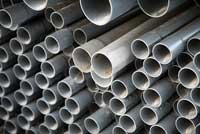Jul 1 2008
The Plastic Pipe and Fittings Association (PPFA) is releasing North America’s first Life Cycle Inventory (LCI) for the manufacture of plastic plumbing pipe. Richard Church, PPFA’s Executive Director stated: “The release of this completed LCI report to PPFA members, LCI databases and the general public allows for increased transparency of the industry’s sustainability efforts, expands knowledge about the relative environmental impacts of its products and underscores PPFA’s sustainability leadership.”

The LCI (a component of a Life Cycle Analysis) is the first phase of three planned for a complete Life Cycle Analysis (LCA) on plastic plumbing pipe. It evaluated the environmental profiles of selected pipes most commonly used in three plumbing applications: service lines, water distribution, and drain, waste and vent (DWV) applications. Plastic pipe manufacturing data was modeled by Franklin Associates, using resin production data released in 2007 and published in the U.S. LCI Database www.nrel.gov/lci. Current plastic pipe fabrication data were collected for this study and averaged from plastic pipe producers, a majority of which were PPFA members.
The PPFA LCI will be submitted to LCI databases and to the Building for Environmental and Economic Sustainability (BEES) program. BEES is a National Institute of Standards and Technology (NIST) program and an ISO compliant LCA- based selection tool. LCA-based product selection tools are critical for unbiased green and sustainable building material and product decision making. PPFA encourages other piping material industries to develop and submit LCI data to LCI databases to allow for greater transparency.
The LCI report studied included: 4-inch solid wall PVC pipe, made with both virgin resin and 50% postconsumer recycled (PCR) content, cellular core PVC pipe, and ABS pipe with solid and cellular core for drain, waste, & vent (DWV) applications; 1-inch Polyethylene (PE) pipe and PVC pipe for inlet pressurized water supply applications; and ¾-inch CPVC & PEX tubing for Hot and Cold Water Distribution (HCWD) applications.
The report explores the environmental benefits of plastic cellular core and recycled content DWV pipe, and potential energy, landfill reduction, and carbon dioxide implications of energy recovery from waste-to-energy incineration of post-consumer plastic pipe. It also considers the environmental impacts from the extraction of natural gas and petroleum (the raw material feedstocks for plastic resins), through the production of resin to the manufacture of the products.
Some conclusions based on the LCI are:
- Light weight piping products generally have lower environmental burdens than heavier products so they reduce manufacturing, transportation and disposal burdens
- Plastic piping systems show a relatively low energy consumption profile in their manufacturing process. Therefore, plastic pipe extrusion processes are clean and low impact manufacturing operations
- Reducing emissions of CO2, a greenhouse gas, could be accomplished by the selection of products with lower total process and transportation energy requirements, such as plastic pipe.
To access the study results, visit PPFA at www.plasticpiping.org/PPFA_Manufacturing_LCI_Report.pdf.